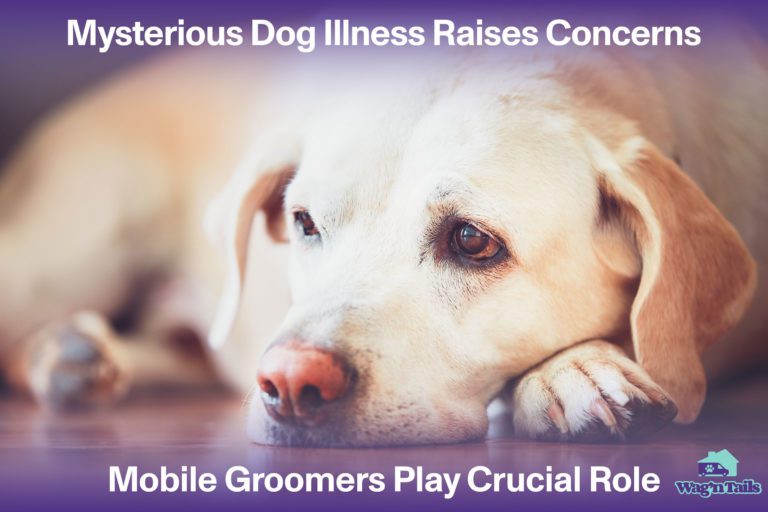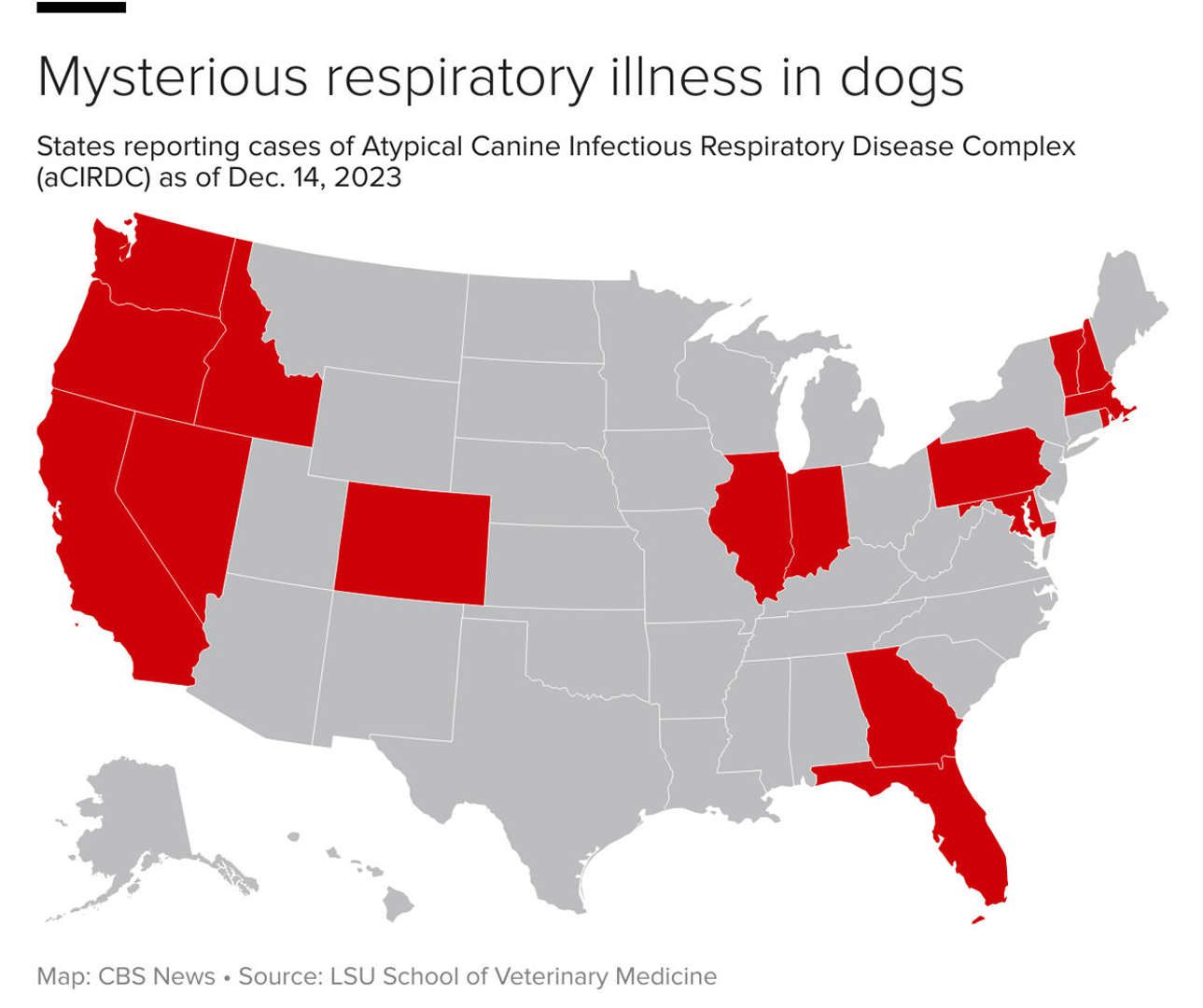Mysterious Dog Illness Raises Concerns, Mobile Groomers Play Crucial Role
Uncategorized
|7 min read

By: Jason Mills, Director of Marketing at Wag’n Tails Mobile Conversions
As a pet care professional by now you’ve probably heard about the atypical canine infectious respiratory disease complex (CIRDC) that is affecting dogs across the country – aka, the mystery dog flu. Although the exact number of cases remains unknown, reports indicate symptoms include coughing, sneezing, and lethargy.
The Dalai Lama is attributed as having once said, “if tragedy strikes, don’t lose hope. Transform it into an opportunity to make things better.” That said, as a mobile groomer, this illness presents a unique opportunity to position yourself as part of the solution.
This is because many of the features that make your Wag’n Tails van a quality investment, also make it the perfect counter measure to this illness. So, how do you communicate these benefits to your new and existing customers? And what exactly should you be telling them?
First, let’s cover what this illness is and what it isn’t.
Although it shares a lot of the same symptoms, it’s not kennel cough. Like kennel cough, most cases start with a dry, hacking cough.
“Kennel cough specifically is caused by another bacteria called Bordetella bronchiseptica, and then there are a lot of viruses that can cause the same type of symptoms,” said Dr. Nancy Welborn, Associate Professor of Community Practice with the LSU School of Veterinary Medicine. “Symptoms starting out look very similar. The dogs are coughing.”
Unlike kennel cough, however, dogs seem to have a persistent dry cough for six to eight weeks and affected dogs may also show signs of lethargy, fever, decreased appetite, nasal discharge, respiratory distress, or pneumonia, according to the Indiana State Board of Animal Health (BOAH) and the Oregon Veterinary Medical Association (OVMA).
According to Oregon State Veterinarian Dr. Ryan Scholz, “common respiratory diagnostic testing has been largely negative.” This means that although this CIRDC shares similar symptoms as kennel cough, it doesn’t test positive for the disease and is resistant to standard treatments.
“The three choices are: There is not a new disease out there. There is a disease whose incidence is particularly high right now and it’s a known agent,” says Dr. Kurt Williams, Director of the Oregon Veterinary Diagnostic Laboratory, “Or there’s truly something new and novel out there.”
Which dogs are at risk?
Reports show the disease can affect all breeds, but breeds with flat faces or short noses, like French Bulldogs, seem to be the most susceptible. Very young puppies, older dogs, dogs with pre-existing respiratory conditions and immunocompromised dogs are also susceptible. On the bright side, this CIRDC does not seem to be especially fatal.
“Fatalities do not seem to be a large part of the syndrome we are investigating, with rare animals developing an acute and sometimes fatal pneumonia after the longer chronic disease,” said Dr. David B. Needle, a pathologist at the New Hampshire Veterinary Diagnostic Laboratory and clinical associate professor at the University of New Hampshire. “We think these may represent secondary infections.”
As a pet care professional, what should you look for?
As a pet care professional, you are uniquely positioned to monitor pets for signs of illness. Early detection can be key to preventing further spread. You should ask pet parents if their dog has shown any respiratory symptoms, such as a lingering cough, weakness, loss of appetite, difficulty breathing, or a cough so severe that the dog vomits or has trouble breathing. If they say yes, the owner should be advised to seek veterinary care immediately.
“Mobile grooming serves as the first line of defense in early detection of respiratory diseases in dogs,” said Dr. Dustin Borth, owner/operator of Clay Oaks Veterinary and Wag’n Tails veterinary expert. “With their personalized and one-on-one approach, mobile groomers closely observe not only the physical appearance of the dogs but also their behavior and overall well-being. This attentiveness enables them to identify any signs of respiratory distress, such as coughing, wheezing, or labored breathing. By promptly notifying owners of these potential symptoms, mobile groomers significantly aid Veterinarians in the early diagnosis and treatment of respiratory diseases, ensuring the best possible care for our furry friends.”
Lasting six to eight weeks, one of the things that separates this CIRDC from other canine respiratory diseases is its persistence. So, if you groom a dog that has had a cough for more than one appointment, you should encourage their owner to take them to the vet.
What can you do?
As a mobile groomer, you can play a pivotal role in managing this CIRDC by maintaining high sanitation standards, closely monitoring canine clients, educating pet owners, and adjusting operation protocols. According to the American Veterinary Medical Association (AVMA), ensuring all equipment and surfaces are disinfected after each household is essential. Groomers should use veterinary-grade disinfectants, proven effective against a broad spectrum of pathogens.
“Proper sanitation and requiring appropriate vaccination is the foundation of disease prevention in mobile grooming,” Borth said. “By ensuring stringent cleanliness practices such as regular disinfection of tools and equipment, maintaining a clean environment, and practicing good hygiene, mobile groomers play a crucial role in preventing the spread of diseases such as CIRDC. Their commitment to safeguarding both the pets and the owners contributes to a healthier and safer grooming experience.”
If you’re looking for more steps to take, then consider adjusting appointment schedules to minimize cross-contact between dogs. Your goal should be to provide enough time between households for thorough cleaning and ventilation of the salon. This doesn’t necessarily mean that you should groom fewer pets. Rather, you should plan on keeping your Wag’n Tails van thoroughly cleaned and ventilated. Be prepared to explain to nervous pet parents what steps you’re taking to keep their furry family members safe.
What should you communicate to your customers?
Don’t just take precautions – communicate the precautions that you’re taking. You should regularly be posting your cleaning processes, the use of high-quality disinfectants, and even snippets of how you manage and maintain hygiene in your mobile unit. Use your social media to demonstrate your commitment to your furry clients’ health and well-being by showing the measures you’re taking to prevent the spread of this CIRDC.
If you’ve boosted your cleaning protocol, then you should explain what you’ve done in a social media post. Don’t assume that your customers know what you’re doing or what steps you’ve already taken; especially if you haven’t told them what you’ve done.
Are you taking dogs’ temperatures when you pick them up? Snap a quick photo of yourself doing it, and then post it to social media. Are you disinfecting between every appointment? Take a 30-second video on your phone to illustrate what you’re doing.
If you have a customer who is weary, explain that with mobile grooming the risk of exposure to illnesses is minimized. Explain the benefit of personalized, one-on-one service. Point out that unlike traditional salons, which often handle multiple pets simultaneously, mobile groomers typically work with one pet at a time. This reduces the risk of cross-contamination and offers a more relaxed environment for the pet. Although this seems obvious, it’s important that you restate this to your customers.
Most importantly, communicate to pet parents that although they should be cautious, they should try not to worry.
“Dog owners should not be worried — instead exercise caution and be intentional in protecting the health of their pets,” said Melissa Justice, a veterinarian with the Indiana State Board of Animal Health (BOAH). The OVMA echoed Justice’s sentiment, “We suggest caution rather than worry.”
Worry can make us do crazy things. For example, during the pandemic, when people were trying not to leave their homes, Joanna Keefe, the owner of Joana’s Animal Grooming Salon, said she saw dogs with nails embedded in their paws, matted hair, or cuts on their skin. “Those kinds of things are more concerning [than the illness] to us and the community of groomers and vets.”
Communicate to your customers that, according to the AVMA, dogs can be contagious and still look perfectly healthy, so pet owners should limit their dog’s interaction with other dogs. Explain to them that this is another reason why mobile grooming is a good choice.
The AVMA explains that pet owners should avoid large groups of dogs with unknown health or vaccination statuses – such as brick and mortar grooming salons. It’s also recommended that pet owners should keep their dogs away from toys and food and water bowls that could be used by dogs outside of their household. They should also avoid areas where outbreaks are occurring and should keep their dog away from other dogs if it’s sick.
Finally, you should reassure your customers that, although this CIRDC is serious, it shouldn’t stop them from getting their dogs groomed.
“We are not seeing an uptick in respiratory disease outside of the ordinary expectation for pets that would get respiratory disease,” said Dr. Stephen Kochis, the chief medical officer for the Oregon Humane Society.
Closing thoughts
We’re all in the pet care business because we love animals, and we want what’s best for them. That said, we know that you want to take the necessary precautions to make sure you’re doing everything you can to keep the animals in your care safe and healthy, and we hope that this article helps you do just that!
Remember:
- Clean your Wag’n Tails van between households.
- Be sure to use veterinary-grade disinfectants.
- Ensure all equipment and surfaces are disinfected.
- Keep your Wag’n Tails van well ventilated.
- Keep your vents open and running all day!
- This CIRDC is airborne.
- Closely monitor your furry clientele and communicate with your customers if you notice anything concerning.
- Does the animal appear weak?
- Does it have a lingering cough?
- Has it lost its appetite?
- Is it having difficulty breathing?
- Does it have a severe cough?
- Does it have nasal discharge?
- Lastly, remember to be cautious, but try not to worry.
- Be intentional in protecting the health of the animals in your care.

© Provided by CBS News
Jason Mills



